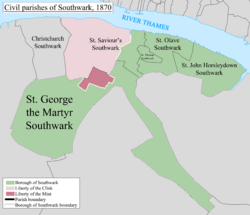Liberty of the Clink facts for kids
| Liberty of the Clink Manor of Southwark |
|
 |
|
| Geography | |
| Status | Liberty, Manor |
| History | |
| Created | 1127 |
| Abolished | 1889 |
| Succeeded by | County of London |
Quick facts for kids Politics |
|
|---|---|
| Governance |
|
The Liberty of the Clink was a special area in Southwark, a part of London on the south side of the River Thames. It was located right across from the City of London. Even though it was in Surrey county, this "liberty" had its own rules. It was not under the usual county sheriff's control. Instead, it was managed by the Bishop of Winchester, who was often an important advisor to the King, like the Chancellor or Treasurer.
Contents
How the Liberty of the Clink Started
This special area began as part of a larger piece of land in Southwark. This land was given to a religious house called Bermondsey Priory around 1104-1109 by King Henry I.
Later, in 1149, the Priory sold this land. It was bought by Henry of Blois, who was the Bishop of Winchester. He was also the younger brother of King Stephen. The Bishop wanted a place in London for his important government work.
The Bishop's Manor in Southwark
The Bishop's administration called this area the Manor of Southwark. This meant it was the Bishop's own estate within Southwark. It was also known as the 'Liberty of Winchester'. A "liberty" was a special area where the local lord, in this case the Bishop, had his own legal powers. King Stephen officially approved this arrangement, making it a true liberty.
The Famous Clink Prison and Palace
The Clink area is most famous for its prison. The name "Liberty of the Clink" was first officially used around 1530. People used this nickname to avoid confusing it with other manors in Southwark.
Why Was it Called 'The Clink'?
The name 'Clink' likely came from the Bishop's prison. This prison was part of the Bishop's power as a civil authority, linked to his role as the King's Chancellor or Treasurer. It was also the local jail for the manor, managed by the Bishop as part of running the liberty. The Bishop's main home in London, Winchester House, was built in this liberty. It was once surrounded by large parklands.
Activities Allowed in the Clink
Because the Liberty of the Clink was outside the control of the City of London and Surrey county, some activities that were not allowed in those places were permitted here. This made the Clink a unique and sometimes lively area.
Famous Theatres and Plays
Many theatres and playhouses were allowed in the Clink. The most famous was the Globe Theatre, where William Shakespeare performed his plays. Another well-known theatre was The Rose. Both Shakespeare and Christopher Marlowe had their plays shown for the first time at The Rose.
Old English Sports
Other activities permitted in the Clink included bull and bear baiting. These were popular, though often cruel, forms of entertainment in those times.
How the Liberty Was Governed Locally
The Liberty of the Clink was part of the parish of St Margaret's, Southwark until 1539. After that, it became part of the parish of St Saviour's, Southwark.
Clink Paving Commissioners
In 1786, a new law created the Clink Paving Commissioners. These commissioners were in charge of paving, cleaning, lighting, and watching the streets and public areas within the Manor of Southwark, also known as The Clink. You can still find old stone posts marked "Clink 1812" in the Bankside area today. These posts were part of the work done by these commissioners.
Joining a Larger District
From 1855, the Clink area became part of the St Saviour's District. This district also included St Saviour's and Christchurch in Surrey. This larger district was managed by the Metropolitan Board of Works. This board took over the powers that the paving commissioners used to have.
The End of the Liberty
During the time of the Commonwealth (when England was a republic), the power of bishops was removed. The liberty was sold to a private owner in 1649. However, it was given back to the Bishop when the monarchy was restored in 1660.
Buildings Destroyed
The Clink prison was destroyed in 1780. The Bishop's palace was also destroyed later, in 1814. By 1863, the Bishop of Winchester's rights over the liberty were given to the Ecclesiastical Commissioners, a group that managed church property.
Final Abolition
The Liberty of the Clink officially ended in 1889. This happened when the Local Government Act 1888 merged all remaining liberties into their surrounding counties. The Liberty of the Clink had been surrounded by Surrey. However, the 1888 act created a new County of London in the metropolitan area. So, the liberty became part of this new County of London.
Where Was the Clink?
The liberty covered about 70 acres (28 hectares). It was located in what is now the Bankside area of the London Borough of Southwark. Streets like Clink Street and Winchester Walk still remind us of its past as a special liberty.

